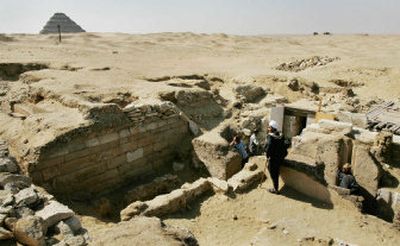Criminals unearth dentists’ ancient tombs

SAQQARA, Egypt – The arrest of tomb robbers led archaeologists to the graves of three royal dentists, protected by a curse and hidden in the desert sands for thousands of years in the shadow of Egypt’s most ancient pyramid, officials announced Sunday.
The thieves launched their own dig one summer night two months ago but were apprehended, Zahi Hawass, chief of Egypt’s Supreme Council of Antiquities, told reporters. “We have to thank the thieves,” Hawass said.
That led archaeologists to the three tombs, one of which included an inscription warning that anyone who violated the sanctity of the grave would be eaten by a crocodile and a snake, Hawass said.
A towering, painted profile of the chief dentist stares down at passers-by from the wall opposite the inscription.
The tombs date back more than 4,000 years to the 5th Dynasty and were meant to honor a chief dentist and two others who treated the pharaohs and their families, Hawass said.
Their location near the Step Pyramid of King Djoser – believed to be Egypt’s oldest pyramid – indicate the respect accorded dentists by Egypt’s ancient kings, who “cared about the treatment of their teeth,” Hawass said.
Although their services were in demand by the powerful, the dentists likely did not share in their wealth.
The tombs, which did not contain their mummies, were built of mud-brick and limestone, not the pure limestone preferred by ancient Egypt’s upper class.
“The whole point of a tomb was to last forever,” said Carol Redmount, associate professor of Egyptian archaeology at the University of California at Berkeley. “So you wanted to make it out of materials that would last forever. And mud-brick … didn’t last forever.”
During a visit to the site, Hawass pointed out two hieroglyphs – an eye over a tusk – which appear frequently among the neat rows of symbols decorating the tombs. He said those hieroglyphs identify the men as dentists.
The pictorial letters also spell out the names of the chief dentist – Iy Mry – and the other two – Kem Msw and Sekhem Ka. Hawass said the men were not related but must have been partners or colleagues to have been buried together.
Figures covering the pillars in the doorway of the chief dentist’s tomb tell archaeologists much about his life and habits, Hawass said.
They depict the chief dentist and his family immersed in daily rituals – playing games, slaughtering animals and presenting offerings to the dead, including the standard 1,000 loaves of bread and 1,000 vases of beer.
These would “magically provide food and sustenance for the spirit of the dead person for all eternity,” Redmount said.
Although archaeologists have been exploring Egypt’s ruins intensively for more than 150 years, Hawass believes only 30 percent of what lies hidden beneath the sands has been uncovered.